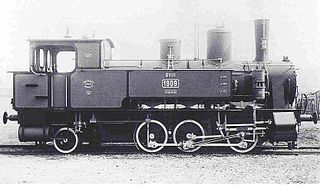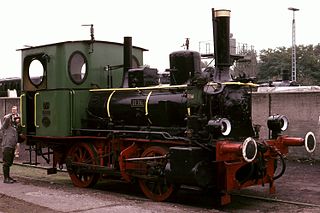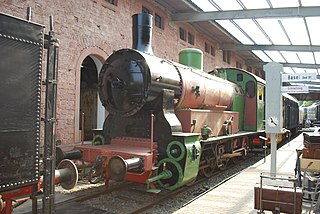
The Bavarian Class D XI engines were branch line (Lokalbahn) saturated steam locomotives built for service with the Royal Bavarian State Railways.
The Bavarian Class D X engines were saturated steam locomotives of the Royal Bavarian State Railways.

The Bavarian Class D VIII were saturated steam locomotives with the Royal Bavarian State Railways.

The Bavarian Class Gt 2×4/4 engine of the Royal Bavarian State Railways, was a heavy goods train tank locomotive of the Mallet type. It was later designated the DRG Class 96 by the DRG, DB and DR.

The Bavarian Class D VI were German, 0-4-0, steam locomotives of the Royal Bavarian State Railways. They were light, twin-coupled, saturated steam, tank engines. Maffei supplied the first 30 locomotives from 1880 to 1883, and Krauss delivered a further 23 up to 1894.
Locomotives 9 and 10 of the Lokalbahn AG (LAG) were saturated steam locomotives that were built for the Murnau - Garmisch-Partenkirchen route opened in 1889.

The Bavarian Class GtL 4/4 engines were superheated steam locomotives in service with the Royal Bavarian State Railways for duties on branch lines (Lokalbahnen).

The Bavarian Class D XII steam locomotives were manufactured by the firm of Krauss from 1897 for the Royal Bavarian State Railways. Ninety six of them were procured for service on the stub lines running from Munich into the mountains, but in reality they were stationed in many large Bavarian locomotive depots. Two engines were transferred to the Palatinate Railway (Pfalzbahn) in 1916, the remaining 94 later joined the Deutsche Reichsbahn fleet and were incorporated as DRG Class 73.0-1 with operating numbers 73 031–124.

The six-coupled P 5 of the Palatinate Railway (Pfalzbahn) was to replace the four-coupled locomotives in the Palatinate. They were given a leading Krauss-Helmholtz bogie and a trailing bogie in order to achieve satisfactory weight distribution.
The Class 98.11 steam locomotives of the Deutsche Reichsbahn were rebuilds of the Bavarian Class GtL 4/4.
The Bavarian engines with railway numbers 87 and 88 were superheated steam locomotives with the Localbahn AG (LAG). They were the last two engines that the LAG procured because shortly after their delivery in 1937, the company was finally nationalised. The locomotives were largely similar in their design to the TAG 7 locomotive, that had been developed in 1936 by Krauss-Maffei for the Tegernsee Railway AG. TAG 7 were the last branch line (Lokalbahn) locomotives to be designed and built in Bavaria. Unlike the two LAG engines, TAG 7 survived, first as the operating reserve for the Tegernseebahn and later as a museum locomotive. It is maintained by the Bavarian Localbahn Society and regularly used for museum trips around Munich.
Three different types of German electric goods train locomotive belonged to the Deutsche Reichsbahn's DRG Class E 91. In addition to the standard locomotives (Einheitslokomotive) described below there was also a Prussian class that was given the designation E 913 in 1927.
The DRG locomotive classification system was developed by the German Imperial Railway Company or Deutsche Reichsbahn-Gesellschaft (DRG), which was formed in 1924 following the merger of the German state railways (Länderbahnen) in 1920. A common classification and numbering scheme was needed in order to organise effectively the four hundred or so different steam locomotive classes taken over from the state railways, as well as new locomotives. This process lasted until 1926. Only then was the final renumbering plan fixed.

The German DRG Class 95 are ten-coupled tank locomotives with a 2-10-2 wheel arrangement, which were procured by the Deutsche Reichsbahn in 1922 for hauling heavy goods trains on steep main lines. Because the development of this class was started by the Prussian state railways, it was designated as the Prussian Class T 20.

After the Second World War, the Deutsche Reichsbahn in East Germany had a requirement for powerful goods train locomotives with a 15-18 tonne axle load for routes in the Mittelgebirge, the mountainous areas in the south of the country. As a result, the DR Class 58.30 emerged, as part of the so-called 'reconstruction programme', based on rebuilds of the former Prussian G 12 locomotives. Between 1958 and 1962, 56 locomotives, originally from various state railways were converted at the former repair shop, RAW Zwickau.
The Prussian T 9 was a class of German steam locomotive which included several types of tank engine, all with six coupled wheels and two carrying wheels operated by the Prussian state railways.

Class T 5 of the Palatinate Railway was a German, goods train, tank locomotive class with five coupled axles and no carrying axles.
The Palatine T 4II was a class of saturated steam, tank locomotives operated by the Palatinate Railway.
The locomotives of Palatine Class T 4I were saturated steam tank engines operated by the Palatinate Railway. Krauss delivered four of them in 1895 and a further three in 1897. The development of these engines had been based on the second batch of Bavarian D VIII engines and they differed only in a few dimensions: for example, the diameter of the carrying and coupled wheels was smaller. In addition they had a larger coal tank.










